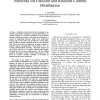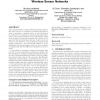24 search results - page 2 / 5 » The MSO Theory of Connectedly Communicating Processes |
MOBIHOC
2002
ACM
14 years 6 months ago
2002
ACM
This paper investigates two fundamental characteristics of a wireless multihop network: its minimum node degree and its k?connectivity. Both topology attributes depend on the spat...
GLOBECOM
2007
IEEE
14 years 1 months ago
2007
IEEE
—To understand how node mobility and Byzantine node failures affect connectivity of wireless multi-hop networks, this paper investigates resilience of geometric random graphs to ...
MOBIHOC
2010
ACM
13 years 4 months ago
2010
ACM
In many practical scenarios, nodes gathering at points of interest yield sizable connected components (clusters), which sometimes comprise the majority of nodes. While recent anal...
JNW
2008
13 years 6 months ago
2008
Recently overlay networks have emerged as an efficient and flexible method for content distribution. An overlay network is a network running on top of another network, usually the ...
WISEC
2009
ACM
14 years 1 months ago
2009
ACM
Time synchronization in highly distributed wireless systems like sensor and ad hoc networks is extremely important in order to maintain a consistent notion of time throughout the ...


